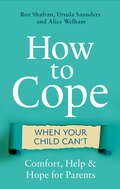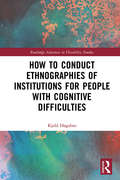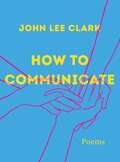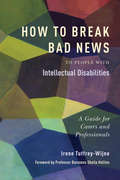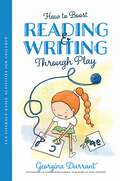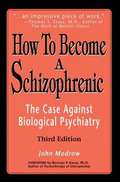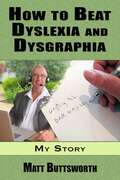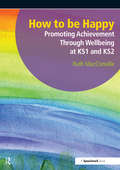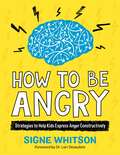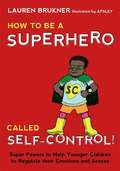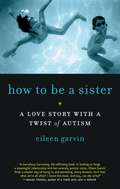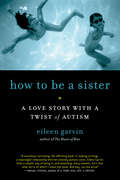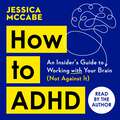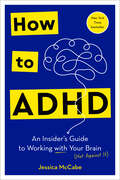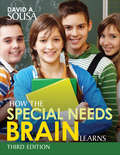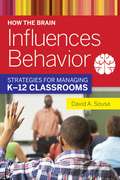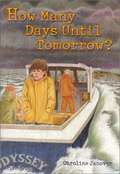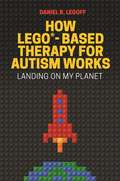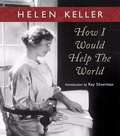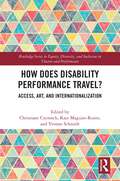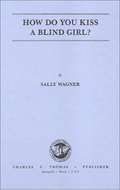- Table View
- List View
How to Cope When Your Child Can't: Comfort, Help and Hope for Parents
by Roz Shafran Ursula Saunders Alice WelhamParenting and caring for a child who is struggling to cope can be painful and stressful, and can make it very hard to enjoy life yourself. Feelings of blame, guilt, sorrow, despair, fear and frustration may be swirling around alongside a desperate desire to cure their pain.Although parenting a child who is experiencing difficulties is a common problem, we can feel desperately alone when it is happening to us. When someone we love is struggling - for whatever reason - we may become unhappy too. For countless parents and children there are problems with no easy solutions. However, that's where this book comes in. It aims to help understand for ourselves what we can and cannot do; to help us to accept any distress, worry, anxiety, sadness or loss of control in our situations; to see that we can tolerate these things; and to know that there are ways to move forward.This book is packed with stories from real parents, combined with information from psychological research. It will show you how you can manage to obtain comfort from knowing you are not alone, get help from resources and techniques that really work, and find hope that things can and do change for the better.
How to Cope When Your Child Can't: Comfort, Help and Hope for Parents
by Roz Shafran Ursula Saunders Alice WelhamParenting and caring for a child who is struggling to cope can be painful and stressful, and can make it very hard to enjoy life yourself. Feelings of blame, guilt, sorrow, despair, fear and frustration may be swirling around alongside a desperate desire to cure their pain.Although parenting a child who is experiencing difficulties is a common problem, we can feel desperately alone when it is happening to us. When someone we love is struggling - for whatever reason - we may become unhappy too. For countless parents and children there are problems with no easy solutions. However, that's where this book comes in. It aims to help understand for ourselves what we can and cannot do; to help us to accept any distress, worry, anxiety, sadness or loss of control in our situations; to see that we can tolerate these things; and to know that there are ways to move forward.This book is packed with stories from real parents, combined with information from psychological research. It will show you how you can manage to obtain comfort from knowing you are not alone, get help from resources and techniques that really work, and find hope that things can and do change for the better.
How to Conduct Ethnographies of Institutions for People with Cognitive Difficulties (Routledge Advances in Disability Studies)
by Kjeld HøgsbroThis book provides a comprehensive analysis of the methodological, theoretical, and meta-theoretical considerations and guidelines involved in undertaking institutional ethnographic work involving people with cognitive and communicative disabilities. It presents a coherent platform for integrating theory and method built on classical and recent anthropological and sociological theory as well as classic and recent methodological considerations within the ethnographic tradition. Furthermore, it introduces readers to the challenging work of understanding the lifeworld of people who cannot express themselves in ordinary ways or who are deeply stigmatised and oppressed by dominating discourses telling them how to understand and define their role in society. It will be of interest to all scholars, students and researchers of disability studies, particularly those who undertake ethnographic research or want to understand the challenges involved in doing so.
How to Communicate: Poems
by John Lee ClarkIn this collection of poems John Lee Clark writes from the inside about the experience of deafblindness. Poems share the richness and intimacy of tactile communication, the hilarity of errors in Sign as used by the hearing, and the complexity of relationships. Several poems explore the lives of historic blind and deafblind figures. Many of these poems were previously published in such literary journals as American Poetry Review, The Paris Review, and Poetry.
How to Break Bad News to People with Intellectual Disabilities: A Guide for Carers and Professionals
by Irene Tuffrey-Wijne Sheila HollinsThis book offers unique and flexible guidelines that can be used by practitioners to ease the process of breaking bad news to people with intellectual disabilities. The guidelines, which are adaptable to individual communication ability and level of understanding, address the many complex needs of people with intellectual disabilities who can find understanding and accepting news that has a negative impact on their life a very difficult task. In the book, Irene Tuffrey-Wijne covers a range of different types of bad news, from bereavement and illness to more minor issues such as a change of accommodation, and offers highly practical and effective tips that will help carers and practitioners ensure that bad news is relayed as sensitively and successfully as possible. An easy-to-use and comprehensive guide, this book will be an invaluable resource of information for carers, health professionals such as doctors and nurses as well as families of people with intellectual disabilities.
How to Boost Reading and Writing Through Play: Fun Literacy-Based Activities for Children
by Georgina DurrantEven if children know their phonics and ABC's inside out and can read every book in their book bag, why is it still so difficult to get them to want to read and write? How do we begin to get our children excited about literacy? The answer might surprise you...let them play!Featuring 40 engaging play-based activities, this book makes literacy so fun that children won't notice they're also actively developing reading and writing skills. From blow painting words to making paper chain sentences, each activity can be done using household items and they are adaptable for children of any age and ability, making learning accessible for all. With charming black and white line illustrations to depict each activity, this is a great way to connect with children while helping to build their literacy skills at the same time.
How to Become a Schizophrenic: The Case Against Biological Psychiatry
by John ModrowThe author describes his experience as a diagnosed schizophrenic and then examines the medical model of schizophrenia, which he believes to be seriously flawed.
How to Beat Dyslexia and Dysgraphia: My Story
by Matt ButtsworthMy name is Matt Buttsworth. I have suffered from dyslexia and dysgraphia all my life and I know how difficult it can be to learn to read or to learn how to write legibly or to type without a thousand uncontrollable errors. I also know as a teacher and from my own at times bitter personal experience how difficult it can be to get effective help, and what terrible obstacles and terrible blows people suffering from dyslexia and dysgraphia can face . <p><p>But despite these disabilities, I have triumphed. I taught myself to read, to type using code systems and to use the latest voice dictation technology to help me create almost error free texts. Something I could never do at an earlier age when all I could do was write or type. And through hard work, perseverance and with the use of these techniques and computer programs I have been able to become a published author with a number of academic texts and novels available for sale on Amazon and to gain a PhD. <p><p>This book is about providing you with the practical skills and the latest available information on which word processing programs and which voice dictation programs someone suffering from dyslexia or dysgraphia should use and how to most effectively use them. I hope you find it of use in helping you too beat dyslexia and dysgraphia.
How to be Happy: Promoting Achievement Through Wellbeing at KS1 and KS2
by Ruth MacConville'Success is not the key to happiness, happiness is the key to success'. Albert Schweitzer Research over the last few years has explored the patterns of thinking, feeling and relating that create human success. It is recognised that wellbeing is not a stand alone feature of individuals, rather it is inextricably linked to that individual's ability to flourish and achieve. The connection between education and happiness is firmly established, confirming what teachers already know, happy children learn and perform better than unhappy children. This programme introduces the core elements of positive psychology and conveys them in a clear and practical way for primary aged children. The 15 sessions aim to teach pupils how to: realise their personal strengths; connect healthily with others; build friendships; and, reach out to trustworthy adults. There are full facilitator notes with all the necessary resources to run an interactive programme that will be delivered with a sense of fun, to engage and inspire all learners. To support the programme the book also contains a section on the key concepts of positive psychology that underpin the sessions, a PowerPoint for staff training and a CD - Rom with copiable resources and useful websites.
How to Be Angry: Strategies to Help Kids Express Anger Constructively
by Signe WhitsonChildren and teenagers often struggle to cope with anger, and angry feelings can boil over into aggression and destructive behaviour. This updated and extended resource takes a different approach to anger, teaching children how to be angry effectively, rather than telling them not to be angry at all.Encouraging appropriate anger management through group work and tailored lessons, the book is also accompanied by downloadable additional resources demonstrating the activities and offering adaptations for parents. Suitable for use with children and teenagers aged 5 - 18, this engaging resource will help children to overcome self-destructive patterns of passive, aggressive, and passive aggressive behaviour.
How to Be a Superhero Called Self-Control!: Super Powers to Help Younger Children to Regulate their Emotions and Senses
by Apsley Lauren BruknerMeet Self-Control, a superhero who wants to teach young children his super powers of self-control! Anxiety, frustration, anger, and other difficult feelings won't stand a chance against their new-found powers. Self-Control teaches children with emotional and sensory regulation difficulties aged approximately 4-7 how to calm themselves using self-massage, deep pressure, breathing exercises, and activities such as making an imaginary list and finding their own peaceful place. This illustrated book also features an appendix with photocopiable super power charts, reinforcers, and reminder tools to ensure that parents, teachers, and other professionals can support children in upholding superhero strategies even after the book has been read.
How to Be a Sister: A Love Story with a Twist of Autism
by Eileen GarvinEileen Garvin's older sister, Margaret, was diagnosed with severe autism at age three causing awkward, hilarious, and heartbreaking situations. What is she going to do about Margaret? Will she remain in Margaret's life, or walk away? How to Be a Sister will speak to siblings, parents, friends, and teachers of people with autism and to anyone who sometimes struggles to connect with someone difficult or different.
How to Be a Sister: A Love Story With A Twist Of Autism
by Eileen GarvinThe first book by acclaimed author Eileen Garvin—her deeply felt, impeccably written memoir, How to Be a Sister will speak to siblings, parents, friends, and teachers of people with autism—and to anyone who sometimes struggles to connect with someone difficult or different. Eileen Garvin’s older sister, Margaret, was diagnosed with severe autism at age three. Growing up alongside Margaret wasn’t easy: Eileen often found herself in situations that were simultaneously awkward, hilarious, and heartbreaking. For example, losing a blue plastic hairbrush could leave Margaret inconsolable for hours, and a quiet Sunday Mass might provoke an outburst of laughter, swearing, or dancing. How to Be a Sister begins when Eileen, after several years in New Mexico, has just moved back to the Pacific Northwest, where she grew up. Being 1,600 miles away had allowed Eileen to avoid the question that has dogged her since birth: What is she going to do about Margaret? Now, Eileen must grapple with this question once again as she tentatively tries to reconnect with Margaret. How can she have a relationship with someone who can’t drive, send email, or telephone? What role will Eileen play in Margaret’s life as their parents age, and after they die? Will she remain in Margaret’s life, or walk away? A deeply felt, impeccably written memoir, How to Be a Sister will speak to siblings, parents, friends, and teachers of people with autism—and to anyone who sometimes struggles to connect with someone difficult or different.
How to ADHD
by Jessica McCabe**From the host and creator of the award-winning HOW TO ADHD Youtube channel**In How to ADHD, Jessica McCabe reveals the insights and tools that have changed her life, while offering an unflinching look at the realities of every day with ADHD. Sharing stories of her struggles with the condition, which spiralled as she approached adulthood, Jessica offers expert-backed guidance for adapting your environment, routines and systems to work with the ADHD brain, including how to:- boost your organisational skills and learn why doing more starts with doing less- facilitate your focus and fight distractions by decreasing the noise- build your time wisdom by planning backwards to prioritise more effectivelyPresented in an ADHD-friendly design and packed with practical advice and tools, How to ADHD is an affirming, warm and helpful guide that will help you recognise your challenges, tackle 'bad brain days', and to ultimately be kinder to yourself.
How to ADHD: An Insider's Guide to Working with Your Brain (Not Against It)
by Jessica McCabeIn this honest, friendly, and shame-free guide, the creator of the award-winning YouTube channel How to ADHD shares the hard-won insights and practical strategies that have helped her survive, even thrive, in a world not built for her brain.&“The world of ADHD has been waiting for this book with bated breath for many years. If there&’s a fairy godmother of our lot, it&’s Jessica McCabe.&”—Edward Hallowell, MD, coauthor of Driven to Distraction and ADHD 2.0Forget &“try harder.&” When your brain works differently, you need to try different. Diagnosed with ADHD at age twelve, Jessica struggled with a brain that she didn&’t understand. She lost things constantly, couldn&’t finish projects, and felt like she was putting more effort in than everyone around her while falling further and further behind. At thirty-two years old—broke, divorced, and living with her mom—Jessica decided to look more deeply into her ADHD challenges. She reached out to experts, devoured articles, and shared her discoveries on YouTube. In How to ADHD, Jessica reveals the tools that have changed her life while offering an unflinching look at the realities of living with ADHD. The key to navigating a world not built for the neurodivergent brain, she discovered, isn&’t to fix or fight against its natural tendencies but to understand and work with them. She explains how ADHD affects everyday life, covering executive function impairments, rejection sensitivity, difficulties with attention regulation, and more. You&’ll also find ADHD-specific strategies for adapting your environment, routines, and systems, including: • Boost the signal and decrease the noise. Facilitate focus by putting your goals where you can see them and fighting distractions with distractions.• Have less stuff to manage. Learn why you have trouble planning and prioritizing, and why doing more starts with doing less.• Build your &“time wisdom.&” Work backward when you plan, and track how long it actually takes you to do something.• Learn about your emotions. Understand how naming your emotions and letting yourself experience them can make them easier to regulate. With quotes from Jessica&’s online community, chapter summaries, and reading shortcuts designed for the neurodivergent reader, How to ADHD will help you recognize your strengths and challenges, tackle &“bad brain days,&” and be kinder to yourself in the process.
How the Special Needs Brain Learns
by Dr David A. SousaTeaching students with learning challenges just got easier with this groundbreaking guide! If you’ve been searching for effective strategies to meet the needs of learning challenged students, look no further. In this newly revised and updated third edition, expert David A. Sousa addresses the causes of common learning disabilities and provides alternative instructional strategies to ensure learning occurs. Discover cutting-edge brain research to help you: Effectively instruct students with ADHD, LD, dyslexia, autism, and more Utilize assistive technologies to remove barriers to learning Differentiate instruction in speech, reading, writing, and mathematics
How the Special Needs Brain Learns
by Dr David A. SousaTeaching students with learning challenges just got easier with this groundbreaking guide! If you’ve been searching for effective strategies to meet the needs of learning challenged students, look no further. In this newly revised and updated third edition, expert David A. Sousa addresses the causes of common learning disabilities and provides alternative instructional strategies to ensure learning occurs. Discover cutting-edge brain research to help you: Effectively instruct students with ADHD, LD, dyslexia, autism, and more Utilize assistive technologies to remove barriers to learning Differentiate instruction in speech, reading, writing, and mathematics
How the Brain Influences Behavior: Strategies for Managing K?12 Classrooms
by David A. SousaCombining theory and practice, David A. Sousa helps educators understand what is happening in the brains of students with behavior problems and offers practical, effective intervention strategies compatible with current findings in neuroscience. In easy-to-understand language, the author presents current information on brain development and function and highlights factors that affect social and emotional decision-making and negative behaviors like impulsivity, defiance, and violence. Comprehensive yet concise, this guide for K-12 teachers and counselors provides methods for teaching self-control and fostering positive relationships with troubled students and provides case studies that match effective strategies with specific behaviors. Educators will find answers to critical questions such as: How does the rate of brain development explain erratic behavior of adolescents? What type of data collection can help teachers manage misbehavior? Can peer influence help curb misbehavior rather than encourage it? Why are boys more likely to misbehave than girls and what can teachers do about it? How do school and classroom climates affect student behavior? This invaluable handbook also features reproducible forms, worksheets, checklists, additional references, and an expanded list of primary research sources to help teachers understand and apply research-based principles for classroom and behavior management.
How Many Days Until Tomorrow?
by Caroline JanoverBack Cover: "Josh is a twelve-year-old with dyslexia who spends the summer with his older brother and grandparents on a remote island in Maine. Rugged island life is torture at first, and his grandfather (alias Grumps) rarely says a kind word. But when Josh discovers the 'cool' Maine sea animals, and meets a cute girl, he forgets about running away. Living on Seal Island is adventurous and demands ingenuity Josh didn't know he had. Josh may not be bookish like his brother Simon, but he has other talents--and ones that help him lead the rescue in a life-threatening emergency." At the end of his time on the island, Josh, his brother and his grandparents have learned valuable lessons about themselves and others. Sequel to Josh: A Boy with Dyslexia.
How LEGO®-Based Therapy for Autism Works: Landing on My Planet
by Daniel B. Legoff"You know, Dr. Dan, that kid is from my planet." With in-depth descriptions of LEGO®-based therapy in action, this book explains how and why it helps to promote the development of social skills for children with autism spectrum disorders (ASDs) and related conditions. Written by Daniel B. LeGoff, who pioneered the approach, this book comprises a series of case histories of children who participated in LEGO® therapy. It traces the development of the evidence-based approach, shares the clinical insights gained along the way and highlights the principles which should be at the core of all effective treatment and educational strategies for children with ASDs. The case histories have real practical value for those working with children with ASDs and also help to demonstrate the subtleties of the adult facilitation role for professionals running sessions.
How It Feels to Live With a Physical Disability
by Jill KrementzKrementz shows through interviews, the indomitable spirit and strength of children living with such physical disabilities as blindness, cerebral palsy, paralysis, and missing limbs. Other books by this author are available in this library, including several from the "How It Feels" series.
How I Would Help the World
by Helen Keller Ray SilvermanHelen Keller's life was deeply changed when she began to read the writings of Emanuel Swedenborg in braille. Referring to him as "one of the noblest champions true Christianity has ever known," she said, "Swedenborg's message has been my greatest incitement to overcome limitations." Certainly, Helen Keller did much to help the world. But she felt she could help the world most by sharing with others the inspiration that came to her through reading Swedenborg's books. "Were I but capable," she said, "of interpreting to others one-half of the stimulating thoughts and noble sentiments that are buried in Swedenborg's writings, I should help them more than I am ever likely to in any other way. It would be such a joy to me if I might be the instrument of bringing Swedenborg to a world that is spiritually deaf and blind." Her essay, How I Would Help the World, is her attempt to do this. It is accompanied by an introduction by scholar Ray Silverman elucidating Helen Keller's spiritual process. This glimpse into the spiritual life of Helen Keller provides inspiration for those who may have wondered how she was able to find the strength and courage to overcome her triple handicap. Pictures of Helen Keller and direct quotations from the writings of Emanuel Swedenborg accompany her poignant words.
How Does Disability Performance Travel?: Access, Art, and Internationalization (Routledge Series in Equity, Diversity, and Inclusion in Theatre and Performance)
by Christiane Czymoch Kate Maguire-Rosier Yvonne SchmidtThis edited collection investigates the myriad ways in which disability performance travels in a globalized world. Disability arts festivals are growing in different parts of the world; theatre and dance companies with disabled artists are increasingly touring and collaborating with international partners. At the same time, theatre spaces are often not accessible, and the necessity of mobility excludes some disabled artists from being part of an international disability arts community. How does disability performance travel, who does not travel – and why? What is the role of funding and producing structures, disability arts festivals and networks around the world? How do the logics of international (co-)producing govern the way in which disability art is represented internationally? Who is excluded from being part of a touring theatre or dance company, and how can festivals, conferences, and other agents of a growing disability culture create other forms of participation, which are not limited to physical co-presence? This study will contextualize disability aesthetics, arts, media, and culture in a global frame, yet firmly rooted in its smaller national, state, and local community settings and will be of great interest to students and scholars in the field.
How Does Being Bilingual Affect Learning?
by Daniel J. OlsonHow Does Being Bilingual Affect Learning?
How Do you Kiss a Blind Girl?
by Sally Roesch Wagner<P>Sally Wagner grew up in Prairie Village, Kan., and received a B.A. in English from Grinnell College. She taught high school English in Lakewood, Colorado, and re ceived an M.A. in journalism from the University of Colorado. She turned from teaching to journalism, but within months came the first signs of what led to blindness three years later. <P>With Andy, her golden retriever dog guide from the Seeing Eye, she took a public relations post, returned to reporting and collected the anecdotes which drew her back to Prairie Village to write this book. Wagner, 42, now covers a police beat for the Kansas City Times from her Prairie Village apartment.
